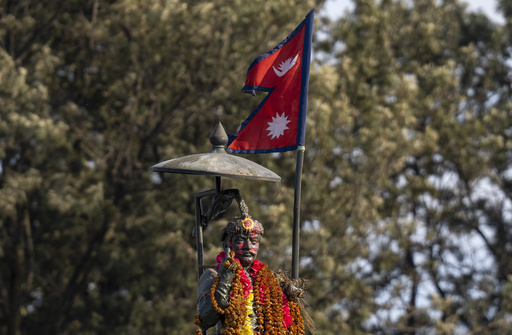KATHMANDU, Nepal (AP) — Sixteen years ago, mass protests in Nepal forced then-King Gyanendra Shah to give up the throne and clear the way for a republic. Now, a new wave of protest is trying to bring him back.
The capital of the Himalayan country is again teeming with demonstrators, this time demanding that Shah be reinstated as king and Hinduism brought back as a state religion. Royalist groups accuse the country’s major political parties of corruption and failed governance and say people are frustrated with politicians.
“Come back king, save the country. Long live our beloved king. We want a monarchy,” the crowd chanted at a rally last month in Kathmandu.
Growing frustration with the present system has led to calls for radical change. Pro-monarchy rallies have been growing larger, and an increasing number of homes and businesses are displaying portraits of the ex-king and his ancestors.
Gyanendra was a constitutional head of state without executive or political powers until 2005, when he seized absolute power. He disbanded the government and parliament, jailed politicians and journalists and cut off communications, declaring a state of emergency and using the army to rule the country.
Protests that drew hundreds of thousands of people forced him to give up power to the parliament in 2006, and two years later parliament voted to abolish the monarchy and Gyanendra left the Royal Palace to live the life of a commoner.
But many Nepalis have grown frustrated with the republic, saying it has failed to bring about political stability and blaming it for a struggling economy and widespread corruption. Nepal has had 13 governments since the monarchy was abolished in 2008.
Many Nepalis believe elected politicians are more interested in power and patronage than addressing their problems, said Dhruba Hari Adhikary, an independent analyst based in Kathmandu. “That’s why some people started to think that, well, it was far better under the monarchy,” he said.
In November, tens of thousands rallied in support of the king in Kathmandu, where riot police officers used batons and tear gas to halt them from marching to the center of the capital.
Kings were long considered reincarnations of the god Vishnu in the majority-Hindu nation.
“The king is the umbrella that is really needed to block and protect (the country) from all the pressure and influence that is being put on Nepal by countries like India, China or America,” said Rudra Raj Pandey, who was among the protesters at last month’s rally.
“Our country will retain its values and identity only if it is turned back to a monarchy and the king is reinstated to the throne,” he said.
But the movement is too small to prevail any time soon, Adhikary said.
With polls and surveys rarely conducted in Nepal, it’s not clear how many people support the monarchy. Gyanendra was an unpopular king, but the monarchy remained broadly popular before he seized absolute power.
The country’s major political parties have rejected the possibility of the king returning to power.
“Nepal is a republic and the monarchy will never be reinstated,” said Narayan Prakash Saud of Nepali Congress, which led the revolt against the kind in 2006 and is currently the largest party in parliament. “The only way it would be possible would be through changing the constitution, but there is no possibility of that happening at all.”
The most powerful group supporting restoration of the monarchy is the Rastriya Prajatantra Party, or national democratic party, which was founded in the 1990s by allies of the monarchy. It has 14 seats in parliament — around 5% — but wields outsize influence as a representative of the protest movement.
Party leaders met with the prime minister in February and presented their demands.
“I think it is very possible and the environment throughout the country has never been so congenial for this agenda,” said Rabindra Mishra, deputy chairman of the party.
“If we can’t restore the institution of the monarchy in this country, there is no future for the youth in this country and the existence of this country itself could be at risk,” he said.
Gyanendra himself hasn’t commented on the movement. He has stayed out of open involvement in politics since his abdication, and only rarely makes public appearances.
Other groups supporting the king have sprung up.
“We need a monarchy. Without a king, we have no identity as Nepalese and all of us might as well just declare ourselves as refugees,” said Pasupathi Khadga, who leads a youth organization that supports the reinstatement of the monarchy.
Nepal’s monarchy did not allow political parties to form until 1990, when a pro-democracy movement brought in elections and reduced the monarchy to a ceremonial role. Gyanendra became king after his elder brother, then-King Birendra, and his family were killed in a massacre at the royal palace in 2001.
___
Follow AP’s Asia-Pacific coverage at https://apnews.com/hub/asia-pacific
This website uses cookies so that we can provide you with the best user experience possible. Cookie information is stored in your browser and performs functions such as recognising you when you return to our website and helping our team to understand which sections of the website you find most interesting and useful.
